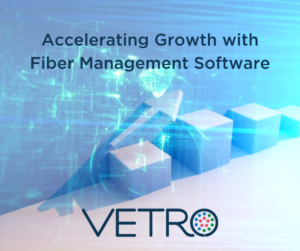The Power of Data: Optimizing FTTH Network Design with Fiber Management Software
Fiber-to-the-Home (FTTH) deployments are revolutionizing internet access, offering blazing-fast speeds and unmatched reliability. But with great potential comes significant planning and execution challenges. Optimizing your FTTH network design requires a data-driven approach, and that’s where fiber management software comes into play.
This article explores the importance of leveraging data in FTTH network design and how fiber management software like VETRO empowers you to make informed decisions at every stage. We’ll delve into best practices for data utilization and highlight the key functionalities of fiber management software that transform your FTTH project from a complex undertaking to a strategic success.
The Data Imperative in FTTH Network Design
Traditional, intuition-based FTTH planning often leads to inefficiencies, delays, and cost overruns. To build a future-proof network that caters to growing bandwidth demands, a meticulous data-centric approach is crucial. Here’s why data is king in FTTH network design:
Informed Decision Making: Data analysis empowers you to identify optimal network layouts. You can pinpoint areas with high subscriber density, analyze existing infrastructure, and plan conduit routes that minimize construction costs.
Accurate Cost Estimation: By accurately mapping existing underground assets and factoring in terrain data, you can create realistic cost estimates. This avoids budget surprises and ensures efficient resource allocation.
Scalability and Future-Proofing: With insights into projected bandwidth needs and subscriber growth patterns, you can design a network that seamlessly scales to accommodate future demands. This eliminates the need for costly network overhauls down the line.
Improved Customer Experience: Data helps you prioritize areas with the most urgent need for high-speed internet access. This leads to faster rollouts and a quicker time to market, ensuring your customers benefit from FTTH sooner.
Fiber Management Software: Your Data-Driven Ally
Fiber management software acts as a central hub for all your FTTH design data. It empowers you to collect, visualize, and analyze critical information, providing actionable insights throughout the entire network lifecycle. Here’s a breakdown of its key functionalities:
Data Integration: The software seamlessly integrates with various data sources like Geographic Information Systems (GIS), existing network maps, and demographic data. This creates a comprehensive picture of your deployment area.
Network Design Tools: Fiber management software offers advanced tools for route planning and network layout optimization. You can model different scenarios, considering factors like distance, terrain, and existing infrastructure.
Cost Analysis and Reporting: By integrating construction costs with route planning, the software generates detailed cost estimates. This allows for informed decision-making when choosing the most cost-effective deployment strategy.
Construction Management: Streamline your construction process with functionalities like permit tracking, resource allocation, and progress monitoring. This ensures efficient deployment and minimizes delays.
Inventory Management: Maintain a clear picture of your fiber assets, including cables, splice points, and other network elements. This simplifies maintenance and facilitates future network upgrades.
Best Practices for Leveraging Data in FTTH Network Design
Now that we understand the significance of data and the power of fiber management software, let’s explore some best practices for leveraging them effectively:
Start with High-Quality Data: The quality of your outputs hinges on the quality of your inputs. Ensure accuracy and consistency in your data sources, including GIS data, demographic information, and existing network infrastructure details.
Identify Key Performance Indicators (KPIs): Define clear KPIs for your FTTH project, such as cost per subscriber, time to market, and network capacity. Track these metrics throughout the design process to measure progress and identify areas for improvement.
Utilize Collaboration Tools: Fiber management software often features collaborative functionalities. Leverage these tools to involve stakeholders from different departments – planning, construction, and marketing – in the design process. This fosters better decision-making and ensures everyone is on the same page.
Embrace Automation: Fiber management software can automate repetitive tasks such as route calculations and cost estimations. This frees up your team’s time to focus on strategic planning and innovation.
Continuously Analyze and Refine: Don’t treat data analysis as a one-time activity. Regularly revisit your data and adapt your design as needed. This ensures your FTTH network remains optimized throughout its lifecycle.
Building a Data-Driven Future with FTTH
By adopting a data-driven approach to FTTH network design, you can create a future-proof infrastructure that meets the ever-growing demand for high-speed internet access. Fiber management software empowers you to leverage data effectively, resulting in a more efficient, cost-effective, and successful FTTH deployment.
Here are some additional benefits to consider:
-
Enhanced Customer Satisfaction: By focusing on areas with high demand and ensuring efficient network operation, you can deliver a consistently reliable and high-quality internet experience for your customers. This translates to increased customer satisfaction and loyalty.
-
Competitive Edge: A well-designed and future-proof FTTH network positions you as a leader in the broadband market. This attracts customers who value speed, reliability, and access to cutting-edge services.
-
Sustainability: Fiber optic cables offer significant environmental advantages over traditional copper cables. They require less energy to operate and have a longer lifespan, contributing to a more sustainable future for your network.
Moving Forward with Confidence
Investing in fiber management software like VETRO is a strategic decision that pays dividends throughout the entire FTTH network lifecycle. It empowers you to plan, design, construct, and maintain a robust network that meets the needs of your customers today and well into the future.
As FTTH technology continues to evolve, so too will the capabilities of fiber management software. By staying at the forefront of data-driven network design, you can ensure your FTTH network remains a valuable asset, delivering high-speed internet access and exceptional customer experiences for years to come.
About VETRO
At VETRO, we believe visualizing data unlocks hidden potential, radically simplifying the way businesses operate and digitizing the future of connectivity. We focus on empowering network operators with unparalleled clarity and control over their fiber networks, enabling them to move faster, better, and more efficiently than ever before. Our revolutionary platform isn’t just software – it’s the physical network asset system of record, offering unprecedented visibility and control from strategic planning to daily operations. We empower our customers to bridge the digital divide at a rapid pace, unlock unforeseen opportunities, and squeeze the maximum value from their networks. Let’s illuminate the unseen, digitize the way we connect, and shape the future of connectivity, together.




